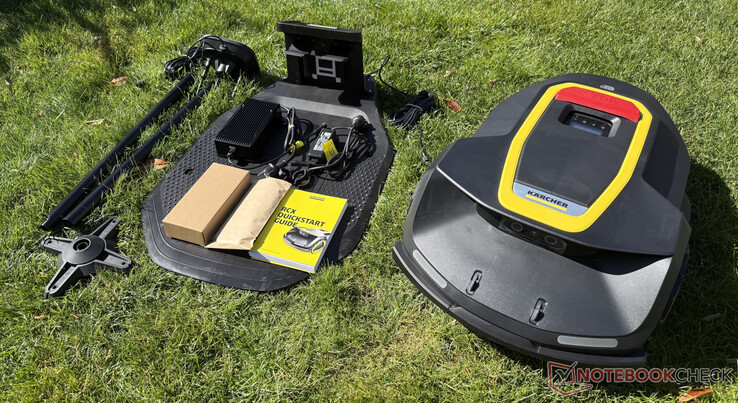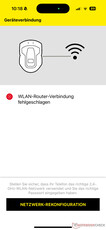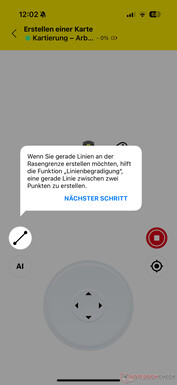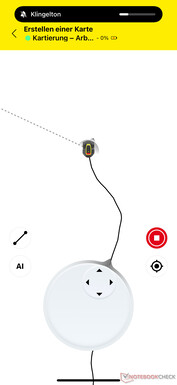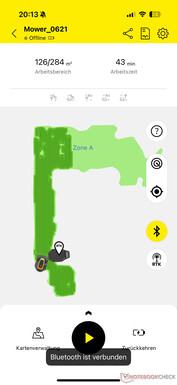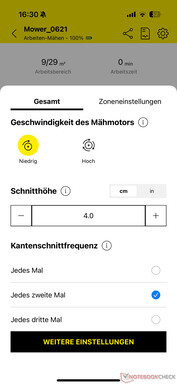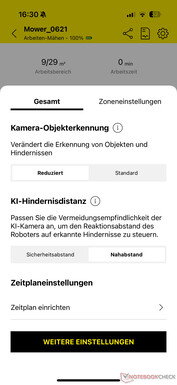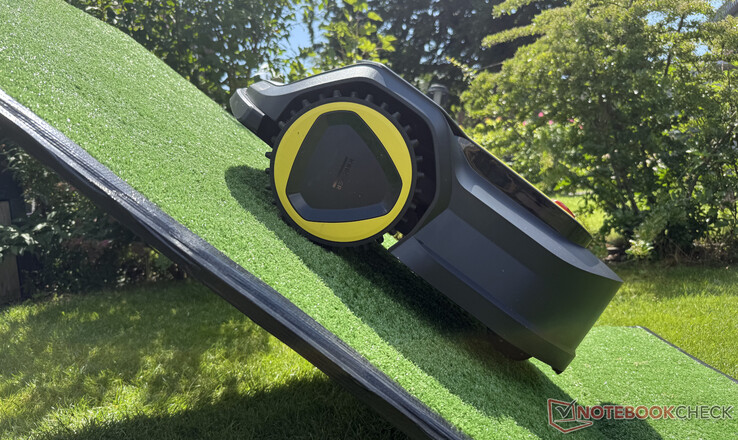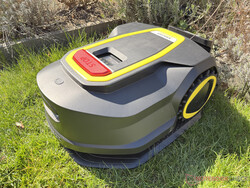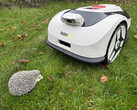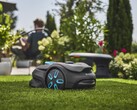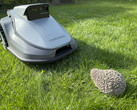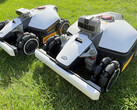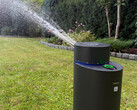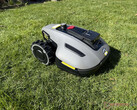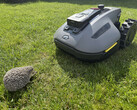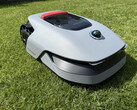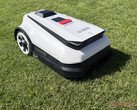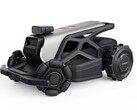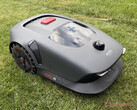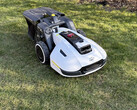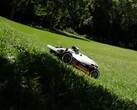
Impressive robot lawnmower: Kärcher RCX 6 review
Mountain goat.
AI camera for obstacle detection, all-wheel drive for slopes of up to 70% and double mower deck with 35 cm cutting width - on paper, the Kärcher RCX 6 is an impressive robotic mower. Our Kärcher RCX 6 review reveals whether it also impresses in practice.Marcus Schwarten 👁 (translated by DeepL / Marcus Schwarten) Published 🇩🇪 🇫🇷 ...
Kärcher RCX 6 test conclusion: Impressive, but potential for improvement
We used the Kärcher RCX 6 over a longer period of time. Unfortunately, there were various minor flaws in the test at the beginning. This tarnished the overall impression, even Kärcher at least partially eliminated them over time with several updates.
In terms of its work on the mowing area, the robot lawn mower made a good impression overall. The fast loading and mowing as well as the impressive climbing capabilities are positive features. There is some criticism regarding the detection of small obstacles and the usual point when mowing edges.
In total the Kärcher RCX 6 does not make a fully developed impression in our test, but overall it is more than solid. Apart from the minor problems, it does its job reliably and quickly mows even large lawns of up to 3,000 square meters, which puts it in the top the best robot mowers 2025.
However, the RCX 6 from Kärcher also has a rather high price tag. The RRP is higher than comparable robot mowers up to 3,000 square meters such as Navimow X3 (X330) and Dreame A2.
Pros
Cons
Price and availability
At the moment the Kärcher RCX 6 is not officially available in the USA. In Europe the recommended retail price for the Kärcher RCX 6 robotic lawnmower is €3,299. However, it is usually already available at significantly lower prices, e.g. on Amazon.
Table of Contents
- Kärcher RCX 6 test conclusion: Impressive, but potential for improvement
- Equipment and scope of delivery: All-wheel drive and 35 cm cutting width
- Setup and maintenance: Annoying Wi-Fi problem
- App and operation: Not flawless, but comprehensive
- Navigation and obstacle detection: not the perfect mountain goat
- Mowing performance and edge cutting: systematic with edge
- Running time and volume: Mows and charges quickly
For the 2025 gardening season, Kärcher has launched its first robotic mower on the market. In the meantime, the top model for lawns of up to 3,000 square meters also has a little brother called the Kärcher RCX 4 (approx. 2,300 euros on Amazon), which can cover a maximum of half that area.
On paper, the Kärcher RCX 6 promises excellent features such as an AI camera, all-wheel drive and a double mower deck with an impressive 35 cm cutting width. But how well does the robot lawn mower perform in practice? Our Kärcher RCX 6 test reveals it.
Data sheet Kärcher RCX 6 and comparison with Kärcher RCX 4
| Property/model | Kärcher RCX 6 | Kärcher RCX 4 |
|---|---|---|
| Area | 3,000 m² | 1,500 m² |
| Navigation and obstacle detection | GPS / RTK / AI camera | GPS / RTK / AI camera |
| Mower | Mowing disk | Mowing disk |
| Number of blades | 6 | 3 |
| Cutting width | 35 cm | 22 cm |
| Cutting height | 2 - 10 cm | 2 - 6 cm |
| Cutting height adjustment | electric | electric |
| Slope | 70% / 35° | 60% / 31° |
| Display | yes | yes |
| Battery capacity | 5 Ah | 3 Ah |
| Weight | 14.4 kg | 12.4 kg |
| Dimensions | 73.5 x 51.0 x 27.0 cm | 68.0 x 42.0 x 27.5 cm |
| Garage included in delivery | no | no |
| Number of spare blades | 18 | 9 |
| Color | Black / Yellow | Black / Yellow |
| RRP | 3,299 euros | 2,599 euros |
Equipment and scope of delivery: All-wheel drive and 35 cm cutting width
On paper, the Kärcher RCX 6 presents itself with powerful features. Designed for lawns of up to 3,000 square meters, the robot mower does not need any boundary wire at all. Instead, it relies on a combination of GPS and RTK as well as 3D stereo AI cameras in the front.
Two slightly offset mowers, each with three free-swinging blades, go about their work, resulting in a considerable cutting width of 35 cm. The cutting height can be adjusted electrically between 2 and 10 cm, so that even high grass can be mowed down bit by bit.
The three wheels are all powered, which results in a climbing ability of up to 70 percent according the information of the manufacturer. In our Kärcher RCX 6 test below, we describe whether it has achieved this in practice. At a good 14 kg, the robot is no lightweight. A handle on the back makes it easier to carry.
In addition to the RTK antenna, the scope of delivery of the large robot mower from Kärcher also includes the obligatory charging station with accessories for fixing it to the ground and 18 replacement blades. Unlike most other manufacturers, the approx. 135 cm high RTK antenna is not fitted with a trident on the underside, but is fixed to the ground with four soil nails. This means that, in theory, an alternative mounting method such as screwing down is also possible. Another unusual feature is that it has its own power supply unit and is not connected to the charging station. This allows it to be positioned more freely, but requires a second power socket.
Setup and maintenance: Annoying Wi-Fi problem
In principle, setting up the Kärcher RCX 6 is very simple. First, a connection is established between the robot and the Kärcher Outdoor Robots app. The Wi-Fi connection is then set up.
Unfortunately, a major problem occurred in one of our two test environments. The robotic lawnmower refused to connect to the existing Wi-Fi network. After a lot of trial and error, we discovered that it was probably not able to cope with one of the special characters in the Wi-Fi password (used for security reasons).
Even after an interim firmware update, it was still not possible to connect the robot to the Wi-Fi when we tried again some time later. However, when using a Wi-Fi network without special characters in the password, it worked without any problems. If necessary, it can also mow without Wi-Fi, but then there is only the option of app control via Bluetooth at close range.
Apart from this annoying problem, setting up the Kärcher RCX 6 worked quite smoothly in the test. Once the WLAN connection is established, the obligatory circling of the mowing area must be carried out in order to create a virtual map. If desired, this can be done automatically using AI detection of the lawn boundary, which worked reliably and without any problems in the test with clearly visible boundaries. However, it is only suitable for simple environments.
Alternatively, manual control is available. In this case, the robotic lawnmower moves quite slowly. Although this takes more time, it enables precise steering and therefore more accurate mapping. A straight line function also provides support if required.
Kärcher recommends cleaning with a damp cloth, but not with a garden hose. The blades cannot be changed without tools, but require a screwdriver.
App and operation: Not flawless, but comprehensive
Apart from the problem with the Wi-Fi setup, we noticed a few other problems with the app during the test. Some of them have already been fixed with an update. Until recently, however, the mowing progress was occasionally not updated in the app even though the robot was connected to the Wi-Fi network.
Otherwise, the Kärcher Outdoor Robots app left a tidy and good impression. The overview shows the live mowing status (when it is working), including square meters and duration. Various icons are positioned around it, which can be used to display a map of the RTK reception in the garden, among other things.
The gear icon at the top right opens the settings. All kinds of options are available here for the path offset (Accurate, Balanced, Efficient), the mowing speed (Slow, Normal, Fast), the cutting direction (Standard, Alternating, Individual) and the speed of the mowing motor (Low, High).
In addition, the cutting height can be set between 2 and 10 cm in 0.5 cm increments, the edge cutting frequency (every time, every second or every third time), the behavior in rain and at night as well as the camera object detection (reduced, standard) and AI obstacle distance (safety distance, close distance).
The usual additional functions such as setting up an automatic schedule, viewing the mowing history and, of course, managing the maps with up to ten zones and virtual walls are also on board.
As an alternative to the app, a control unit is available on the robotic lawnmower. In addition to the large stop button, this includes four other buttons for basic functions and a small display. The screen is illuminated in yellow to match the design and corporate colors, but is difficult to read in direct sunlight.
Navigation and obstacle detection: not the perfect mountain goat
The Kärcher RCX 6 had no GPS reception problems on our two test lawns with only a few trees. On heavily overgrown plots with lots of trees, however, GPS reception could be a problem.
During the first mowing session after the mapping round, it seemed a little confused at first. Afterwards, however, it worked smoothly for the most part. In the test, the robotic lawn mower mostly mowed its paths systematically and reliably covered the lawn areas. Several zones (max. 10) can also be set in the app.
For obstacle detection, Kärcher has installed two AI cameras in the front of the RCX 6 robot lawn mower. Larger obstacles such as a small and a large soccer ball as well as our hedgehog dummy were reliably detected and avoided in the test, as were all natural objects such as trees and bushes.
However, obstacle detection reached its limits with a tennis ball and a piece of hose lying on the lawn. Some robotic lawn mowers in the test did this better, but some did it worse. Above average, even if we had expected a little more.
With dimensions of almost 75 cm in length and 51 cm in width, the Kärcher RCX 6 has a massive appearance, only slightly smaller than the even more massive Navimow X3. Even though it is quite maneuverable with its freely rotating rear wheel and all-wheel drive, its dimensions alone don't make it ideal for use in smaller gardens. Nevertheless, it has also done quite well in tight spaces and masters them up to 80 cm wide. However, it is obvious that it feels more at home in open meadows.
Kärcher quotes an impressive 70 percent maximum gradient capability. This is a huge gradient, which the robot mower did not quite achieve on our test ramp with artificial turf. However, it did manage an impressive 65 percent on the rather slippery surface, making it the mountain goat among the robot mowers we tested.
Mowing performance and edge cutting: systematic with edge
The cutting pattern made a good impression. The app offers various options for adapting the mowing result to your own wishes and local conditions.
However, there is room for improvement (as with the vast majority of robotic lawnmowers) at the edge. Even though two cutting discs are installed, they still have a fairly large distance of 9 cm to the edge of the robotic lawnmower. This means that even with perfect navigation along the edge of the map, which worked quite accurately in the test, approx. 10 cm of unmown lawn remains along transitions that are not at ground level.
In some cases, unfortunately, it is even more. Wherever there are plants hanging over the lawn from adjacent beds, the Kärcher RCX 6 recognizes them as obstacles and makes a small arc accordingly. Unfortunately, obstacle avoidance during edge mowing cannot be completely switched off in the app if desired. This can be partially remedied by reducing the camera sensitivity, but this also leads to a deterioration in obstacle detection in open space. Otherwise, an even better result would be possible, even if it is able to estimate its own height quite well and thus pass under some plants.
Running time and volume: Mows and charges quickly
In the test, the Kärcher RCX 6 worked for just under one and a half hours on a single charge of the 5 Ah battery. It mowed a good 300 square meters before returning to the charging station with 15 percent charge remaining. It only stayed there for around 40 minutes to continue the interrupted work with a full battery charge.
During this time, around 140 Wh with a charging speed of up to 130 W flowed into the battery. We measured the standby consumption of the robot and charging station as well as the RTK antenna at approx. 6 W.
If we take these measurement results and assume a fictitious scenario in which the Kärcher RCX 6 is supposed to mow 500 square meters three times a week, this results in an energy consumption of just over 7 kWh per month. It is clear that the Kärcher robotic lawnmower, which is designed for much larger gardens, is not up to this task. It is primarily used to compare the energy requirements of all the robotic lawnmowers we tested. Here, the RCX 6 is quite economical despite its size.
The Kärcher RCX 6 made a less positive impression in our test with its noise level. At around 58 dB (measured from a distance of one meter), the driving noise of our test device in particular was quite high compared to other robotic lawnmowers tested. This is in line with the 60 dB specified by the manufacturer. Added to this (depending on the activity) are the mowing noises, making this candidate one of the louder representatives of its guild.
Transparency
The selection of devices to be reviewed is made by our editorial team. The test sample was given to the author by the manufacturer free of charge for the purposes of review. There was no third-party influence on this review, nor did the manufacturer receive a copy of this review before publication. There was no obligation to publish this review. As an independent media company, Notebookcheck is not subjected to the authority of manufacturers, retailers or publishers.





